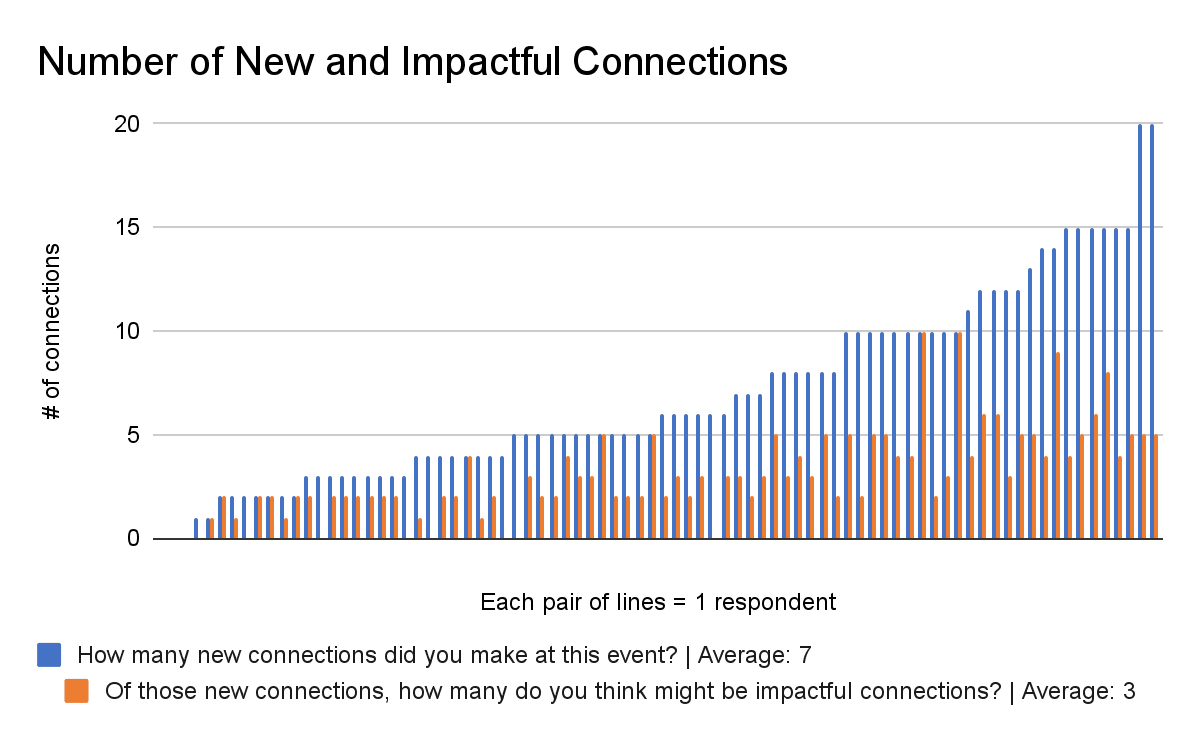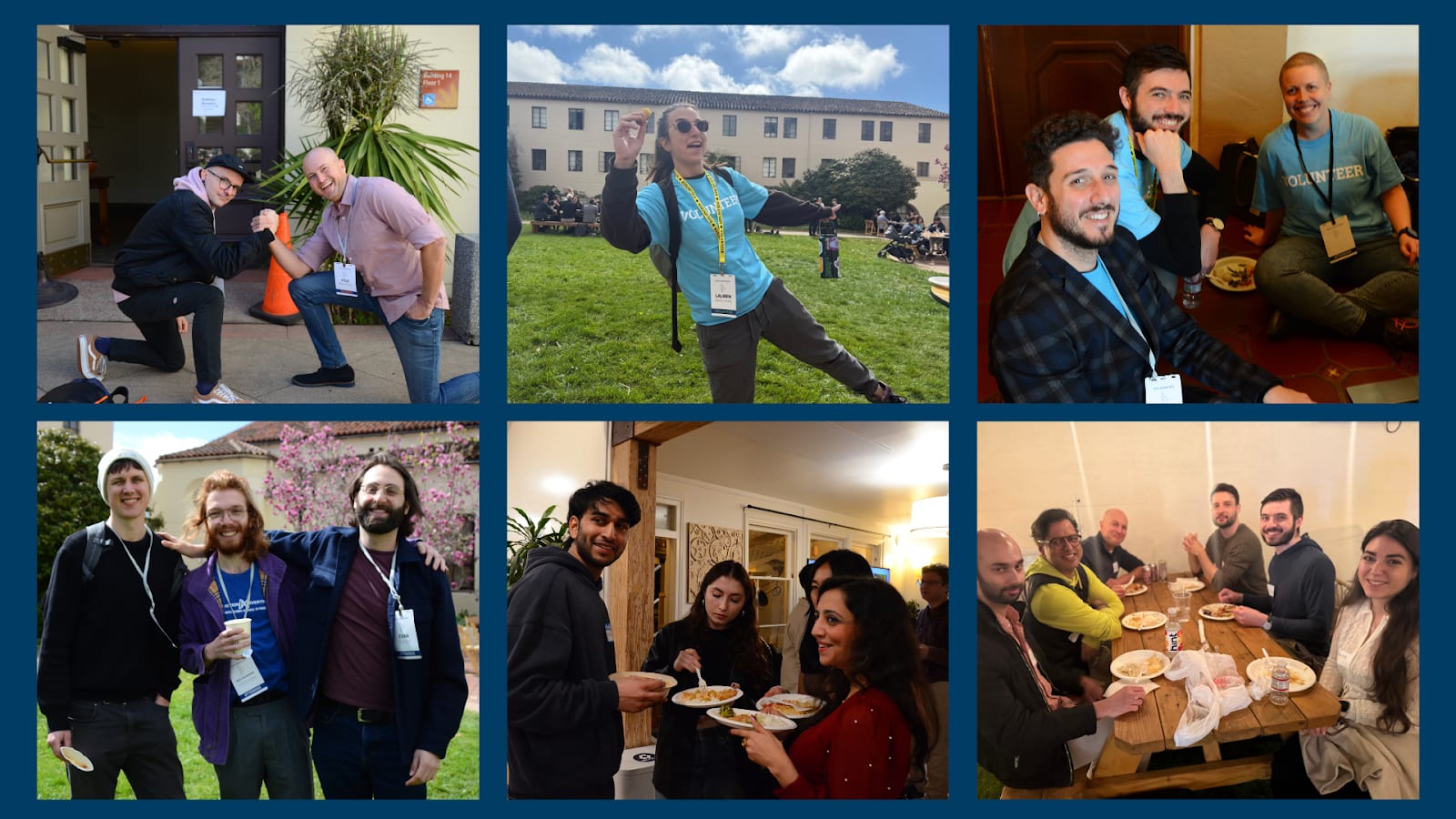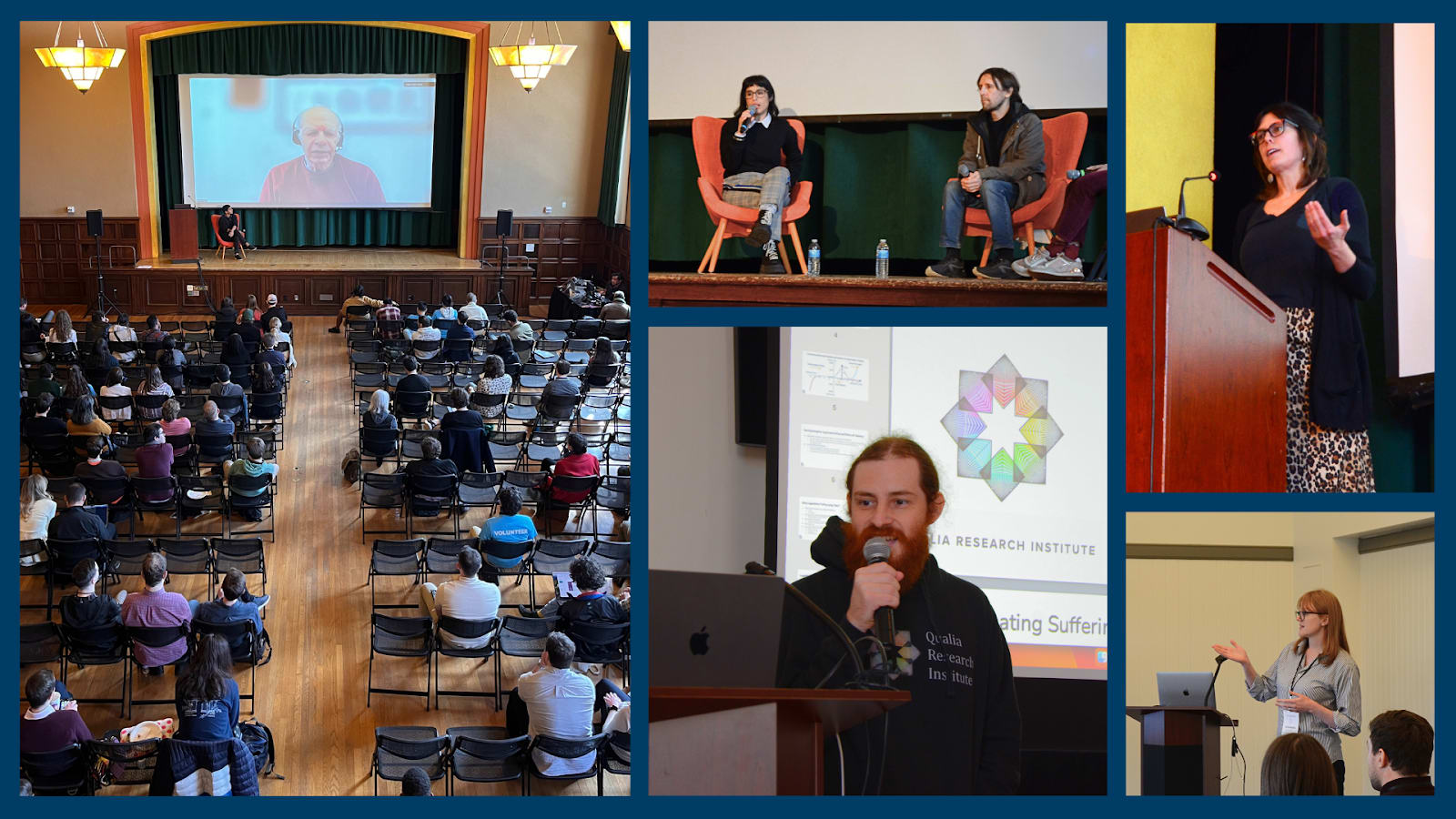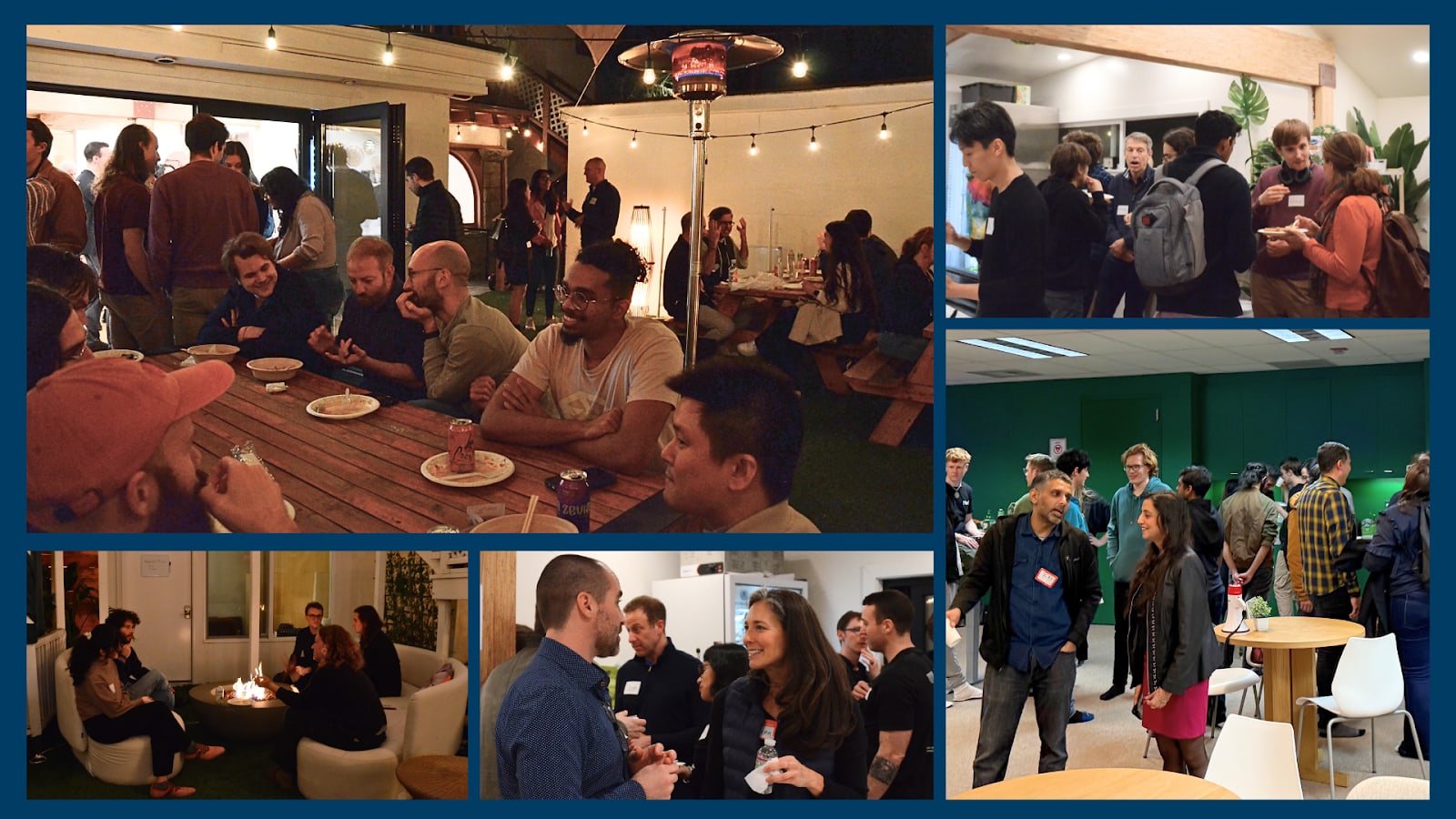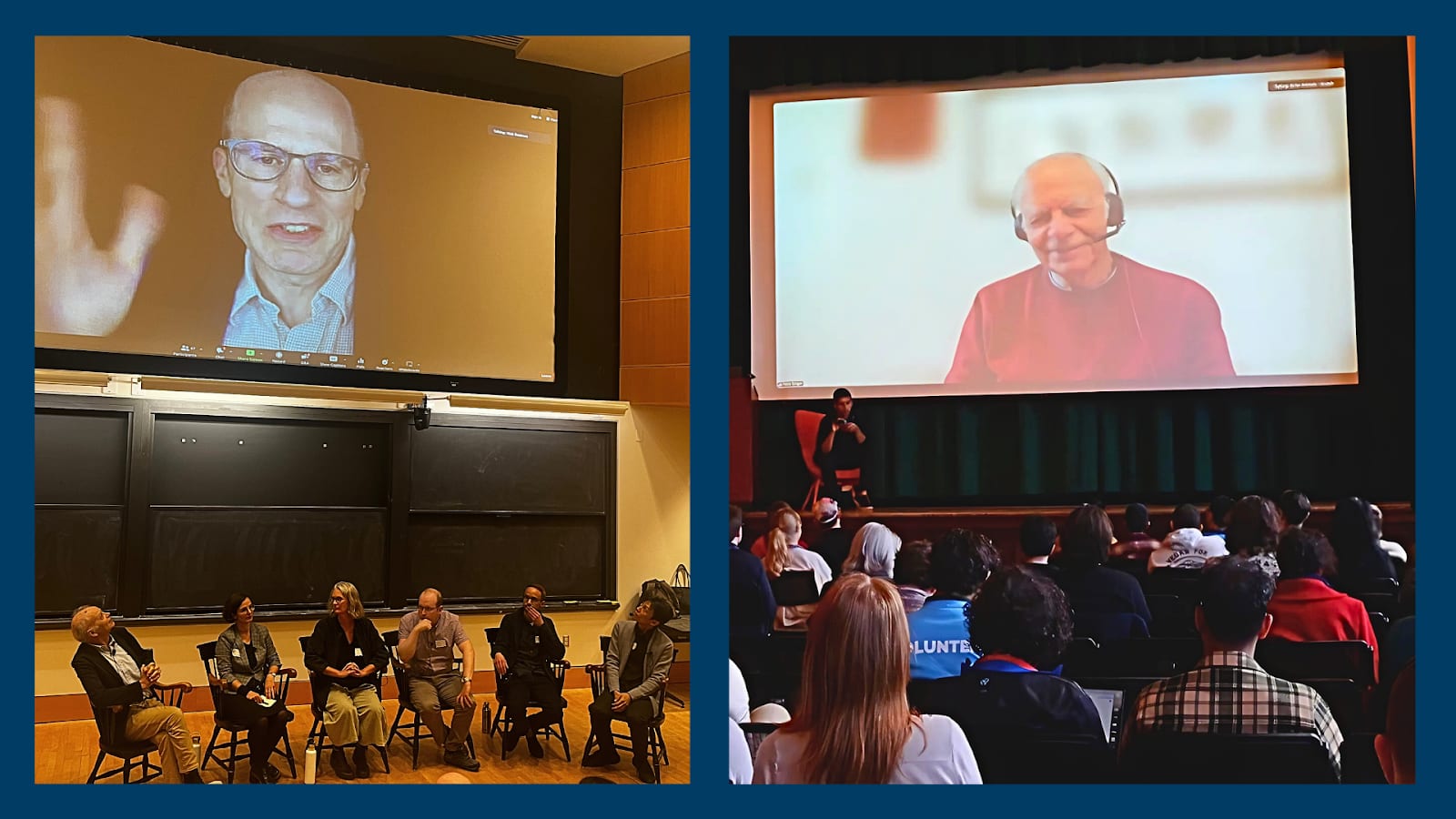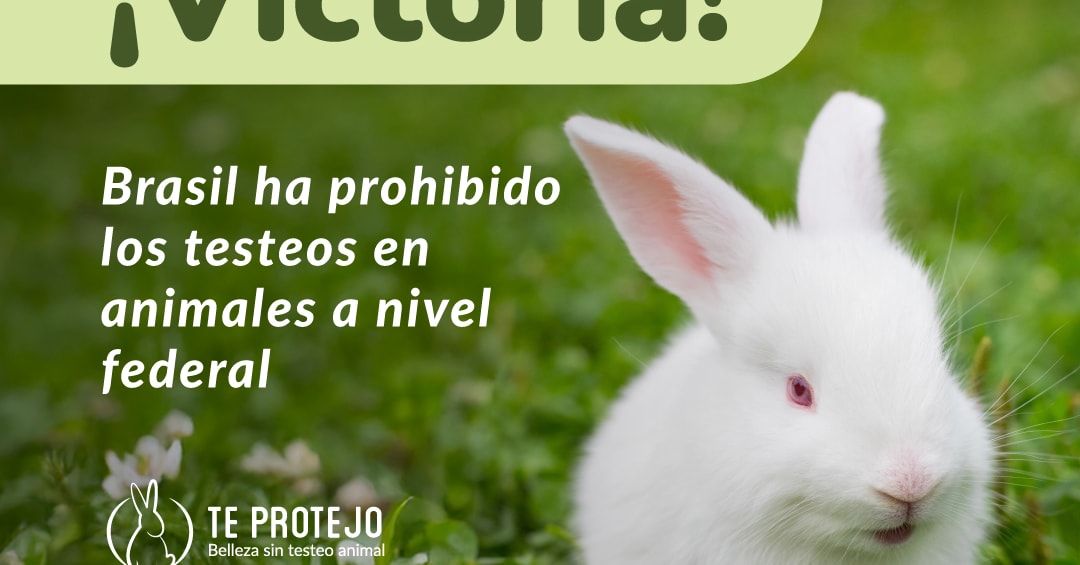
Our Mission: To build a multidisciplinary field around using technology—especially AI—to improve the lives of nonhumans now and in the future.
Overview
Background
This hybrid conference had nearly 550 participants and took place March 1-2, 2025 at UC Berkeley. It was organized by AI for Animals for $74k by volunteer core organizers Constance Li, Sankalpa Ghose, and Santeri Tani.
This conference has evolved since 2023:
- The 1st conference mainly consisted of philosophers and was a single track lecture/panel.
- The 2nd conference put all lectures on one day and followed it with 2 days of interactive unconference sessions happening in parallel and a week of in-person co-working.
- This 3rd conference had a week of related satellite events, free shared accommodations for 50+ attendees, 2 days of parallel lectures/panels/unconferences, 80 unique sessions, of which 32 are available on Youtube, Swapcard to enable 1:1 connections, and a Slack community to continue conversations year round.
We have been quickly expanding this conference in order to prepare those that are working toward the reduction of nonhuman suffering to adapt to the drastic and rapid changes that AI will bring.
Luckily, it seems like it has been working!
This year, many animal advocacy organizations attended (mostly smaller and younger ones) as well as newly formed groups focused on digital minds and funders who spanned both of these spaces. We also had more diversity of speakers and attendees which included economists, AI researchers, investors, tech companies, journalists, animal welfare researchers, and more. This was done through strategic targeted outreach and a bigger team of volunteers.
Outcomes
On our feedback survey, which had 85 total responses (mainly from in-person attendees), people reported an average of 7 new connections (defined as someone they would feel comfortable reaching out to for a favor like reviewing a blog post) and of those new connections, an average of 3 that might be impactful (defined as someone who would accelerate their path to impact by connecting them to a job opportunity or collaborating on a project).
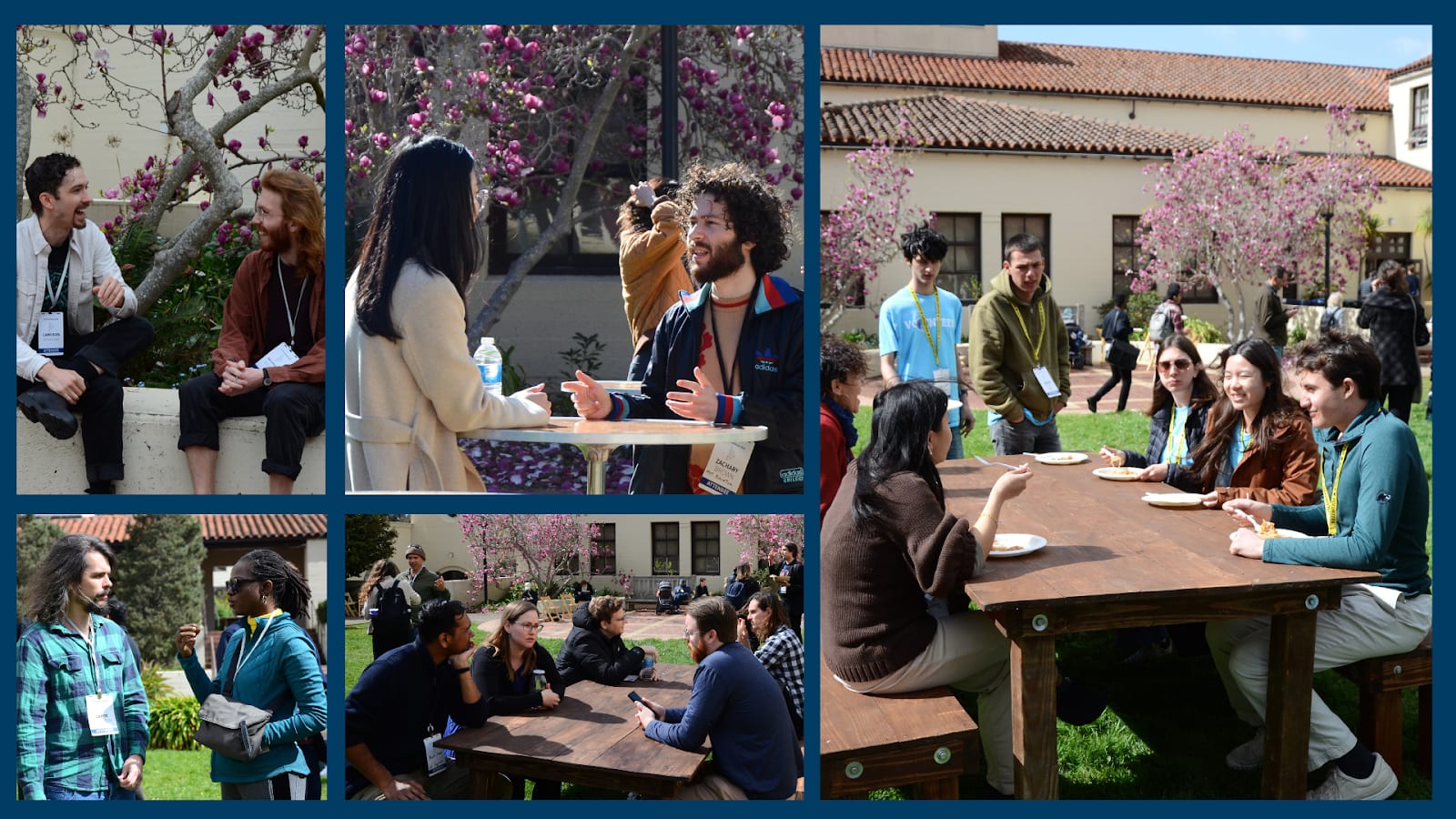
See some quotes from our attendees about highlight (and lowlights) of the conference.
According to Swapcard, there were 2,100 total contacts made and 3,222 messages exchanged.
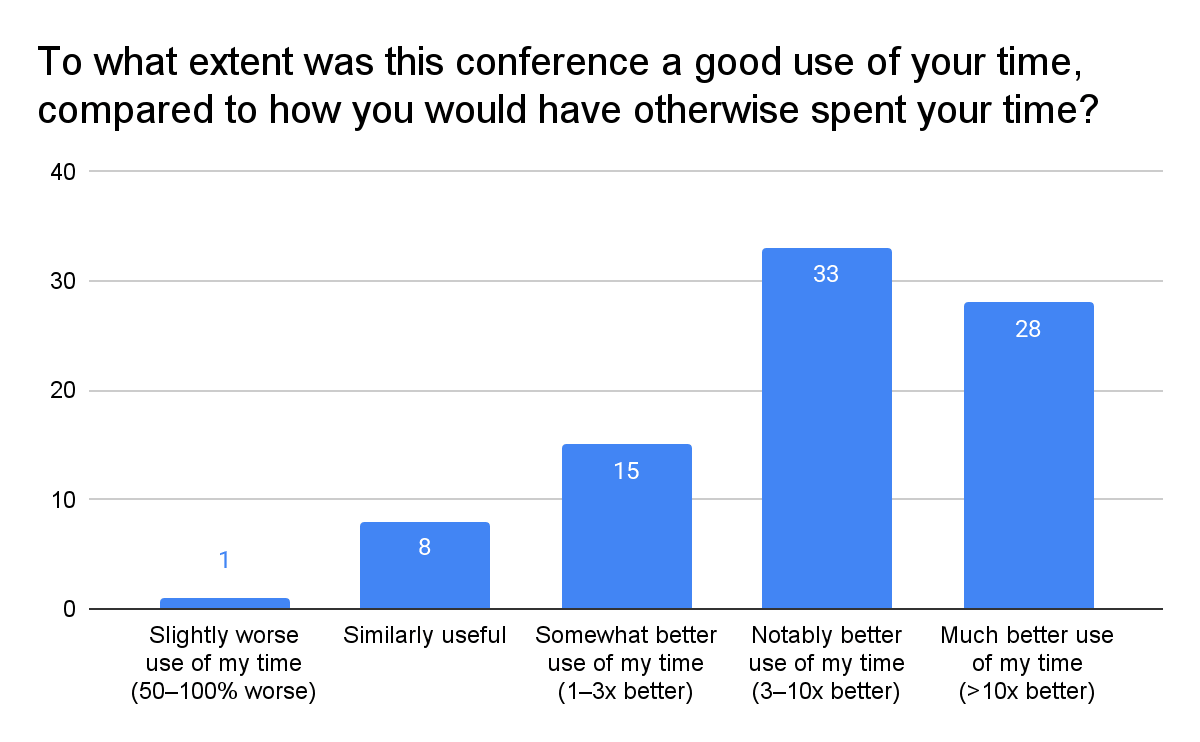
The Event(s)
Overview: Our conference brought together leading thinkers at the intersection of artificial intelligence and animal welfare, featuring 81 unique sessions including keynote presentations, panels, workshops, and interactive meetups.
A selection of the sessions were recorded and are available on on our YouTube channel. Click ▶️ beside their names below to watch.
Speaking Sessions
Featured Talks
- Animal-inspired approaches to assessing sentience in LLMs | Winnie Street
- Animals and Longtermism: A Guide for the Perplexed | Daniela Waldhorn, Prof. Oscar Horta (▶️)
- How Digital Minds Could Reshape Society | Lucius Caviola
- Near term Superintelligence and Relevance for Animal Welfare Plans | Eli Tyre
- Blueprint for a Pan-Species Welfare State: Genome Reform, AI and the Biohappiness Revolution | David Pearce (▶️)
- AI for Wild Animal Welfare – A Review of Current Work and Future Potential | Janire Castellano Bueno
- Aligning PLF with Welfare in Shrimp Farms | Aaron Boddy
- Ethics, Animals, and AI Discussion and Q&A | Peter Singer (▶️)
- Who Matters More, a Bat, a Bee, a Bot? | Prof. Jeff Sebo (▶️)
- Preventing Suffering and Engineering Paradise | Andrés Gómez-Emilsson
- The Relationship Between AI Welfare and Animal Welfare | Kathleen Finlinson (▶️)
- Living in extremely unequal civilizations | Richard Ngo
- AI Alignment – The Case for Including Animals | Soenke Ziesche and Adrià Moret
- The Evolution of Intelligence: Insights from Systems Biology and SETI | Dante Lauretta (▶️)
- Earth Species Project - Breakthroughs in Bioacoustics | Dr. Sara Keen (▶️)
- Legal Standing, Regulatory Valuation of Animals, Choice Architectures, and More | Prof. Cass Sunstein (▶️)
- Large-Scale Autonomous and Non-Invasive Monitoring of Animal Behavior and Motion | Dr. Aamir Ahmad (▶️)
- Computer Vision Changes Everything | John Honchariw (▶️)
- Code4Compassion Hackathon Recap | Ash Singh, Sam Tucker-Davis
- Journalism at the intersection of animal representation and emerging technologies | Xander Balwit, Brandon Keim, Betsy Mason, Max Taylor (Moderator)
- Welfare-oriented Precision Livestock Farming: Going Beyond Productivity Metrics | Sarah Juárez
- Harnessing Artificial Intelligence to Drive Reproducible Insect Science | Meghan Barrett
- Going Deeper Than Tracking: Using AI to Recognize Emotional States and Pain in Animals | Prof. Anna Zamansky (▶️)
- AI for Conservation | Dr. Sara Beery (▶️)
- Introducing the Animal Harm Assessment Benchmark | Arturs Kanepajs
- Exploring the Promise of AI to Transform Animals into Legal Persons | Rajesh Reddy
- AI-Based Camera Surveillance at Slaughterhouses | Carlos Morales
- Protecting Vulnerable Digital Minds – Beyond Suffering Prevention in AI Welfare Science | Soenke Ziesche
- Social Cognition and Thinking about Nonhumans | Janet Pauketat
- Tracking Factory Farms with AI – What's Possible, What's Needed, and How to Bridge the Gap | Rachel Mason
- Willingness to Pay – Simulating Animal Welfare Economics with AI | Bob Fischer and Sankalpa Ghose
- Making Distress Minimal but Adaptive – Advances in Precision Breeding and Biotechnology | Jacob Shwartz-Lucas, Bob Fisher, Eric Gross, Hillel Adesnik
- Animal Law and AI Panel | Jamie McLaughlin and Joan Schaffner
- AI and the Future of Alternative Protein Development | Noa Weiss
- Immediate Strategies for Reducing Distress: From Animal Breeding to Biotechnology | Jacob Shwartz-Lucas, Eric Gross
- Artificial Intelligence and Animal Welfare in Africa: Challenges, Opportunities and the Future | Kikiope Oluwarore
- FireflAI – Community-Driven Computation for Rare Firefly Population Monitoring | Owen Martin
- Agential Harms in the Long-Term Future | James Faville
- The Talk Animal Agribusiness Doesn’t Want You to Hear | Josh Balk, Taylor Ford
- Advancing Farm Animal Welfare with AI – High-Throughput Phenotyping, Precision Monitoring, and Emission Reduction | Dr. Suresh Neethirajan (▶️)
- Representation Is All You Need | Christopher Berry, Sankalpa Ghose (▶️)
- Reading and Q&A Discussion on Animals, Robots, Gods – Adventures in the Moral Imagination | Webb Keane (▶️)
- Reliable Predictions, Real Impact – From AI Toxicity Models to Data-Driven Animal Advocacy | Alexandra Hammond
- Writing with AI – Make it Sound Like You | Kyle Behrend
- Intro to AI Automation | Kyle Behrend
- Artificial Pets and Animal Empathy | Derek Shiller
- Animals in the Machine: A Multi-Species Justice Approach for AI Law And Governance | Leo Bromberg, Christine Parker, Simon Coghlan (▶️)
Lightning Talks
- Making AIs actually care about animals | Miles Tidmarsh (▶️)
- Building Long-Time, Chicken-Resolution Activity Tracking at Scale | Jean-Sebastien Spratt (▶️)
- The Challenge of Autonomous Farming | Prof. Jonathan Birch (▶️)
- Communicating about AI and Animals | Max Taylor (▶️)
- AI and the Animal Caregiver | Dr. Jennifer Walker, DVM, PhD (▶️)
- Wikipedia and Pro-Animal Training Data | Zach Brown
- Introducing Food 4 Thought | Nancy Zhang (▶️)
- AI for Fishes | Shreya Padukone (▶️)
- Risk of Value Lock-in | Nicholas Dupuis (▶️)
- Integrating Risks to Animal Welfare into the EU AI Code of Practice | Keyvan Mostafavi (▶️)
- Demo: Dog Vocalization Hardware | Praful Mathur (▶️)
- Beneath the surface: The animal welfare crisis in Norwegian fish farming | Albert Didriksen (▶️)
- Learn Python, Use AI, Do Anything | Steven Rouk (▶️)
- Towards Ambient Ethology | Emilia Tapprest (▶️)
- Storytelling for Animals and Digital Minds in the AI Era: Different Options | Ronen Bar (▶️)
Interactive Sessions
Unconferences
- Show and Smell | Andrés Gómez-Emilsson
- ChatGPT/LLM Use Cases Speed Share! | Steven Rouk
- Meditative Insights on Animal Liberation | Eric Zhou
- Workshop: Corporate Outreach in the Global South | Konrad Kozaczek
- The Snowball Effect: How Key Tech Cities Can Fuel A Global Movement for Animals | Dean Wyrzykowski
- Writing for AI Audiences | Mikko Järvenpää
- A Massive Interspecies Communication Observatory | Leo Trottier
- Teaching Dogs to Talk | Praful Mathur
- Using Chatbots with Curated Personas to Drive Our Narratives | Cameron Harsh
- Beyond Control: Intrinsic Understanding as a Path to AI Alignment | Lucia Caelum
- Project Ideation Session: AI-Augmented Political Pressure Campaigns | Lance Lively
- Establishing The Moral Alignment Space | Ronen Bar
Meetups
Precision Livestock Farming, Interspecies Communication, AI Benchmarking, Animal Advocacy, Alternative Proteins, Digital Minds, Veterinary Medicine
Mapping Workshops
Precision Livestock Farming, Interspecies Communication
Office Hours
David Pearce, Constance Li, Oscar Horta, Soenke Ziesche, Rob Long and Kathleen Finlinson, Dustin Crummett and Daniela Waldhorn, Jeff Sebo – The Moral Circle Book Reading
Topic Distribution
The following breakdown illustrates how our conference programming was split between different topics.
Satellite Events
Recognizing the significant effort required for attendees to travel, we strategically scheduled this conference one week after EAG. We curated a full lineup of satellite events throughout the interim week, providing participants with valuable work and social opportunities to maximize their time with like-minded individuals in the area.
Behind the Scenes
For even more details, see this accompanying appendix.
Personnel
AI for Animals Team:
- Core Organizers: Constance Li, Sankalpa Ghose, and Santeri Tani
- Program and Volunteer Lead: Sal Melidoro
- Operations and Communications Lead: Chloe Jefferson
- Social Media Lead: Emma Moore
Volunteer Team Leads:
- Logistics: Tyler Marino, Milena Esherick, Nicole Rawling
- Room Management: Alistair Stewart, Serenity Poirier
- Speaker Liason: Megan Jamer, Caleb Maresca
- Registration Desk: Ashley Hoffman, Jamie Hunt
Thanks to everyone who made the conference run smoothly!
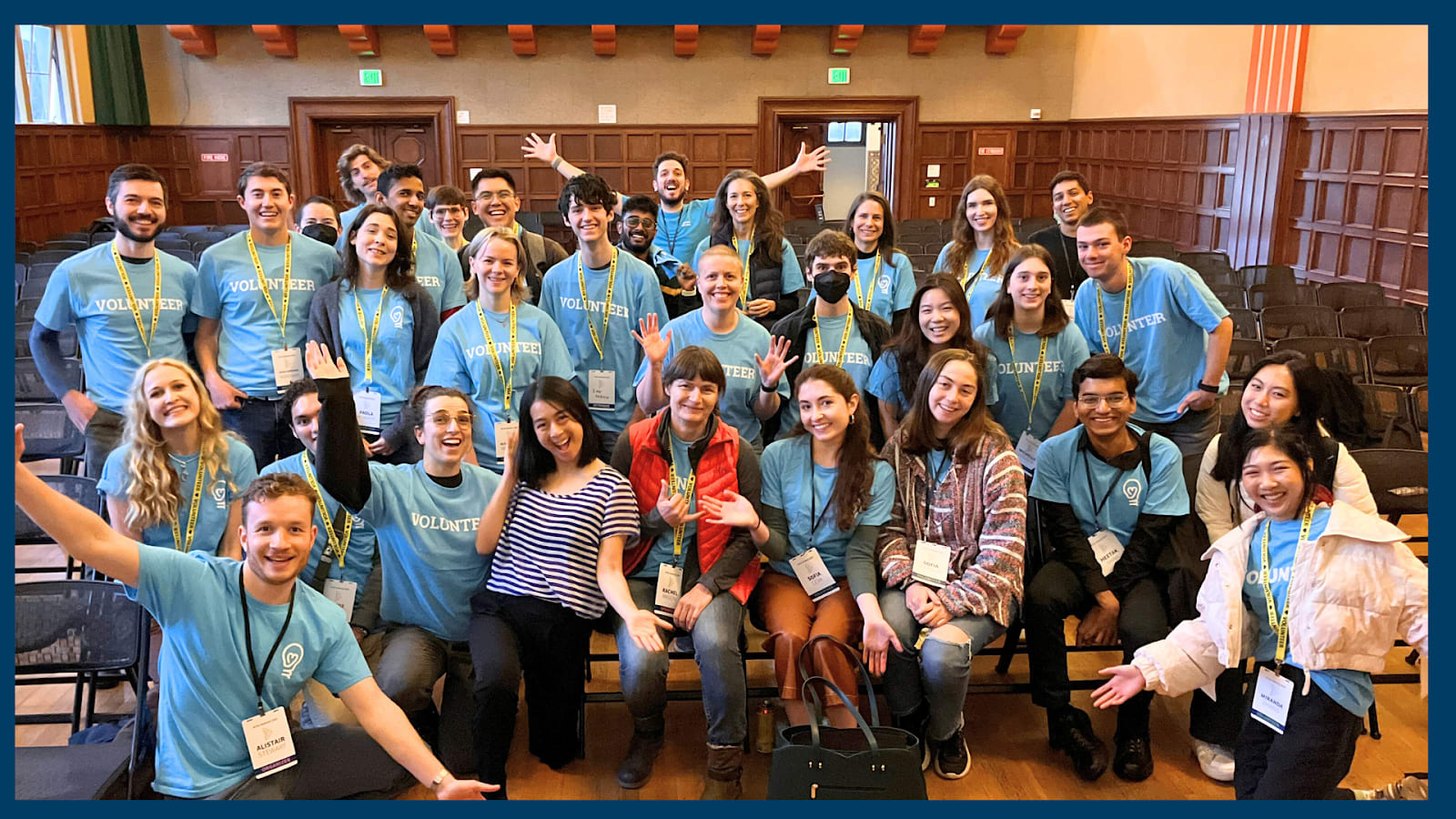
Handbooks
We borrowed a lot of what has historically worked from EAG, including many document templates, and adapted it to our needs. It is a great format and we wanted to iterate, not reinvent the wheel. See our comprehensive guides for attendees and volunteers.
Finances
The total cost for the conference was approximately $74k for 250 in-person attendees over 2 days along with related expenses in the week leading up to the conference. While this represents a significant increase from our previous conference ($~6k for ~60 in-person attendees over 3 days), we believe the expanded investment delivered substantially higher quality. We charged registration fees ranging from $75 - $800 depending on level of financial need, generating ~$23k in revenue.

Here are explainers for some of the major components of our budget:
Accommodations
- Previous Conference: Housing for ~10 people (primarily speakers and volunteers) for 3 days
- Current Conference: Housing for ~50 people (speakers, volunteers, and select attendees) for 2-7 days
- Impact: This investment significantly increased networking opportunities and serendipitous connections. We've already identified one promising invertebrate welfare project that emerged directly from these interactions.
Professional Networking Platform
- Previously, we had a Notion database of all attendees who consented to have their information listed in a directory.
- This year, we purchased Swapcard, which proved essential for creating 1:1 meetings given our larger attendance and the significant overlap with the EAG conference audience
Contractor Compensation
- While our previous conference relied heavily on volunteer coordination (primarily by Constance), this year's expanded scale required more support
- We maintained a primarily volunteer team but team member to ensure proper execution. Full travel support was also provided for team members.
Venue Upgrade
- Previously, we relied on free venues, which resulted in delayed confirmations, overcrowding, and logistical complications.
- Through a partnership with a UC Berkeley student group, we secured a spacious venue at a significant discount.
- The improved facility included a large theater, courtyard, outdoor patio, four breakout rooms, a quiet room, a balcony for storage, and dedicated campus support.
More Meals
- Previously, we only served dinner for 1 night.
- This time, we partnered with Bua Thai restaurant for cost-effective catering for the VIP dinner, both conference lunches, and the hackathon lunch. Leftover boxes were provided for people if they wanted to save some for dinner.
- We streamlined breakfast service by opting instead for snacks throughout the day.
Outreach
We implemented a proactive speaker recruitment strategy beginning 6+ months before the conference. This approach featured personalized outreach and leveraged our existing networks, enabling us to secure high-profile speakers including Peter Singer, David Pearce, and Cass Sunstein well in advance.
Our promotion strategy centered on tailored invitations to special guests who could attract key audience segments that were stakeholders in this field. These invitations included:
- Personalized recognition on our event website with name and photo
- Complimentary or discounted registration
- Exclusive access to our VIP dinner
This strategy was based on the hypothesis that reaching a critical mass of diverse, notable guests would create a snowball effect, attracting additional prominent and relevant participants. We believe a significant portion of the conference's impact stemmed from connecting previously separate communities, including:
- Wild-animal welfare researchers
- Conservationists
- AI researchers
- Animal welfare nonprofits
- Suffering-focused ethicists
- Digital minds researchers
- Journalists
We also did the usual promotional avenues like inviting past attendees, including it in our newsletter, making it the homepage of our website, posting on the EA/FAST Forums, posting on Hive and other Slack workspaces, and starting our Facebook, Instagram, LinkedIn, Bluesky, and X accounts and posting there. Emma wrote this report analyzing the social media strategy she used.
One unique promotion we did was a sneak peak webinar with 3 speakers on a range of topics that would be discussed at the conference.
We also gave out lots of discount codes for people who went to EAG Bay Area or who participated in the Code4Compassion Hackathon.
Event Reflection
What Went Well
- High-profile speakers: We attracted several influential speakers who generated excitement and meaningful discussions among attendees.
- Perfect attendance: All scheduled speakers fulfilled their commitments with no dropouts.
- Professional execution: Multiple speakers specifically praised our thorough organization from initial outreach to the final session.
- Innovative technology: Our custom unconference booking system integrated seamlessly with Swapcard, allowing participants to organize spontaneous sessions.
- Lightning talks: These compact presentations were exceptionally well-received. The format provided a platform for numerous innovative ideas, and speakers appreciated having high-quality recordings to share within their networks.
- Reliable volunteer team: We could not have conducted this event without the flexibility, professionalism, and dedication of the ~35 volunteers who showed up and put in the work. Their willingness to adapt and step up wherever needed made all the difference. Despite giving free registration prior to completion of duties, we still had 95% satisfactory fulfillment.
Areas for Improvement
- Knowledge level indicators: Future sessions should clearly indicate expected knowledge level (beginner vs. advanced) to help attendees choose appropriate sessions.
- Streamlined communications: One dedicated team member should handle all speaker outreach to prevent confusion.
- Earlier agenda publication: The complete schedule should be finalized and published earlier, despite challenges with speakers who prefer not to appear on public schedules.
- Strategic meetup timing: Meetups should be scheduled earlier in the conference to facilitate networking. We plan to restructure these as small, facilitated discussions rather than speed meetings.
- Better structured workshops: The mapping workshops intended for field leaders lacked sufficient structure. In the future, these need clearer communication about purpose and format.
- Unconference support: We should assign a volunteer to check in on unconference sessions and provide support to facilitators.
Nostalgia Note
One beloved element we brought back from our first conference: giant philosopher heads!
Get Involved
We're building a global community at the intersection of nonhuman welfare and artificial intelligence, and there are many ways to contribute to this growing field:
Join Our Next Events
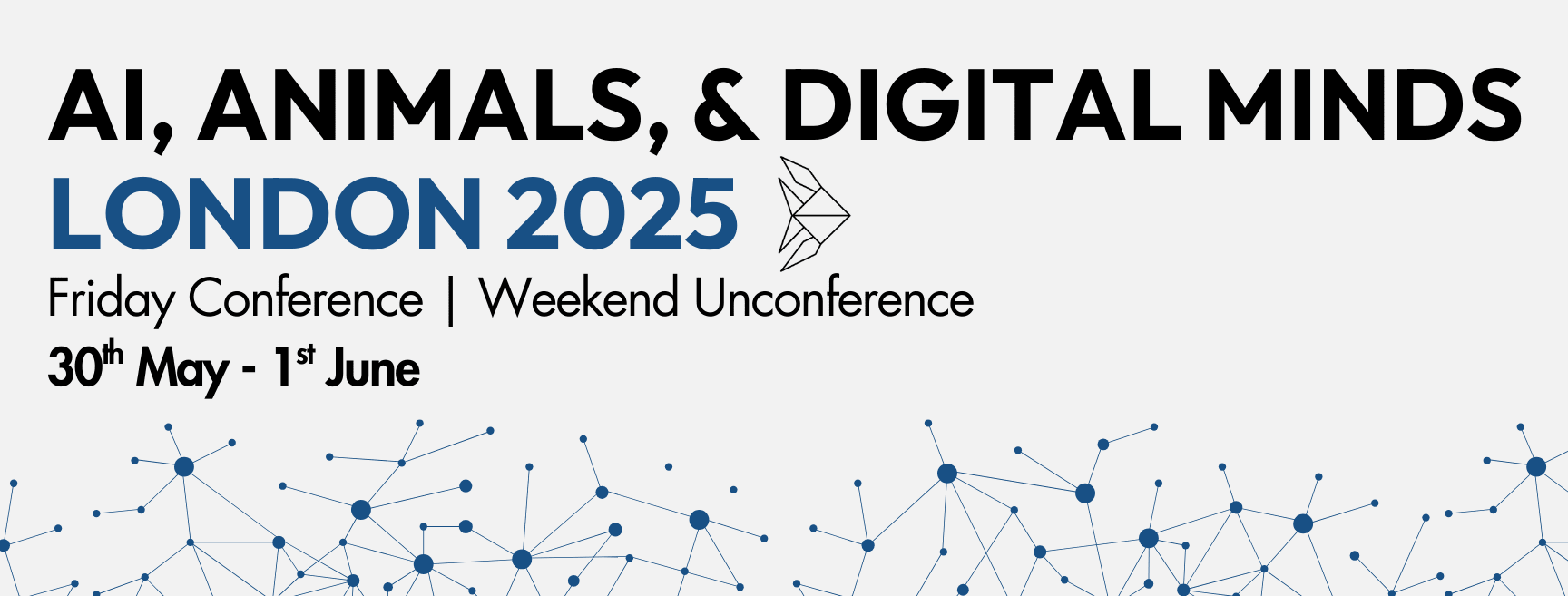
- AI, Animals, and Digital Minds 2025 in London: 30 May - 1 June, 2025
- NYC Satellite Event: Following EAG NYC (dates to be announced)
Ways to Participate
- Subscribe to our Newsletter: Receive updates about upcoming events, news, collaborations, and research opportunities
- Join our Slack workspace: Connect with others interested in the field; stay informed about updates and opportunities; and learn about volunteer opportunities
- Present your work: Submit proposals for talks, workshops, or lightning sessions at upcoming events (AIADM 2025 London Speaker Application)
- Sponsor: Support our mission through financial contributions or in-kind resources
Contact Information
- Email: contact [at] aiforanimals [dot] org
- Website: www.aiforanimals.org
- Social media: X, LinkedIn, Facebook, and more
We look forward to continuing this important work together and welcome your participation in whatever capacity suits your interests and availability.



